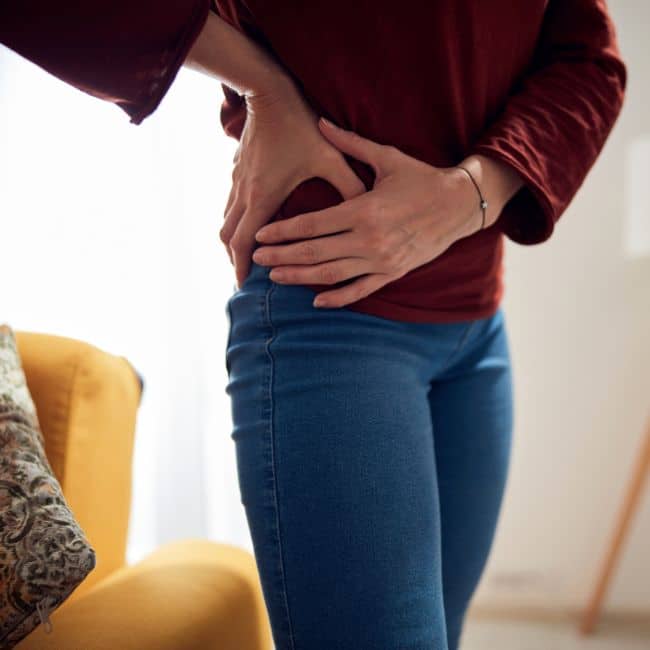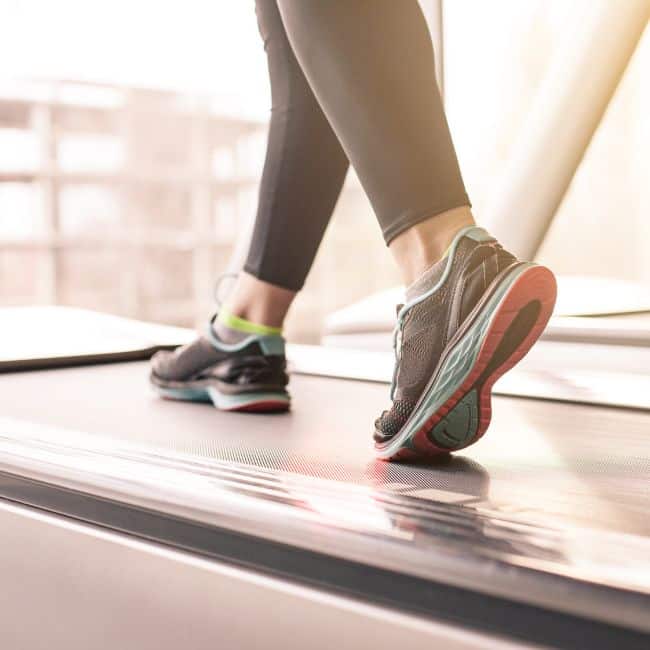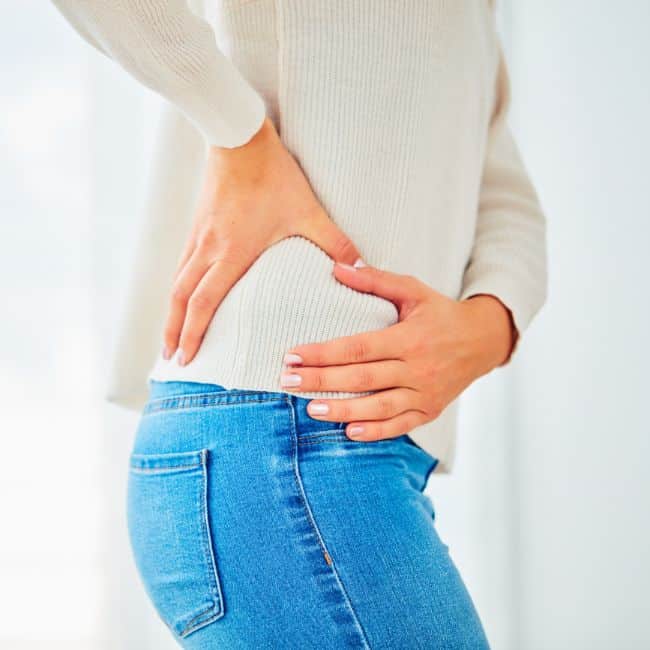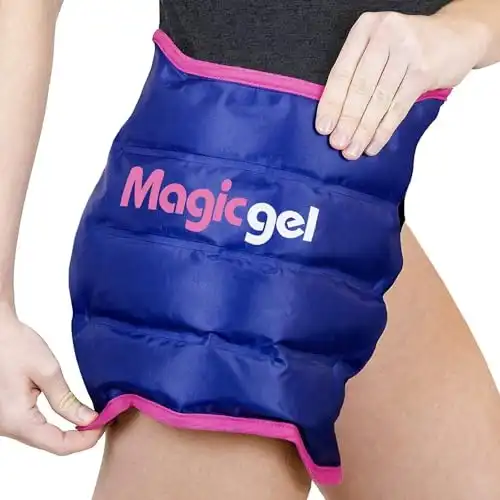The hip is the largest joint in our body, so it’s no surprise that hip problems are a common condition that can be debilitating in everyday life. Explore the best hip pain treatments for non-surgical relief for a better quality of life without invasive procedures.
Hips play a central role in healthy aging. Our hips enable us to do a wide range of daily activities. Whether standing, walking, or climbing stairs, we need them for just about every physical activity. It’s hardly surprising that weakness and pain can cause serious hip conditions.
When the joint we need for everyday movement isn’t at its best, neither are we.
While you should always visit your doctor for chronic or severe pain, there are some hip pain relief treatment options you can try on your own. There are a range of options, from light exercises to homeopathic remedies. We’re going to explore common causes of hip pain, and some of the best hip pain treatments you can try at home.
Table of contents
What Does Hip Pain Feel Like?
Hip pain can vary greatly based on the type of issue and diagnosis that the pain is stemming from. Pain levels can vary from mild discomfort to severe hip pain. For most cases, you can expect to feel any type of pain around or in the hip joint.
You might also experience hip pain in additional areas surrounding the hip joint. For example, you may feel groin, thigh, or knee pain. The ball-and-socket joints of your hips are supported by a number of muscles. This makes sense since it’s one of our largest joints!
Your hip muscles include:
- Glutes (gluteus maximus, medius, and minimus): These muscles are essentially the buttocks. They extend and rotate the thigh outward, stabilize the pelvis, power forward motion, and keep you upright.
- Hip flexors (iliacus, psoas major, rectus femoris, sartorius): The hip flexors are a group of muscles in the front of the hip that help bend your hips and knees.
- Adductors adductor longus, adductor brevis, adductor magnus, gracilis, pectineus): This group of muscles can be found along your inner thighs. They move your legs toward the center of your body (adduction) and help stabilize your pelvis.
Even if your hip pain is nonexistent or minimal at this point, it’s important to keep an eye on it. As we age, the consequences of weak hips only get worse.
Over 300,000 older adults are hospitalized for hip fractures every year, and about half lose the ability to live independently.
Common Causes of Hip Pain
There are many different causes of hip pain, from simple muscle strains and sprains to chronic conditions that require medical intervention. No matter what the underlying cause, remember that the risk for injury and hip joint pain only gets worse with age. Not only is it easier to get injured, but it can be harder to fully recover.
Here are some of the most common causes of hip pain:
Fractures and Falls
If you fracture your hip, you’ll likely experience intense, sudden hip bone pain. These injuries can be serious and lead to other health complications. The risk of hip fracture becomes more common as we age because falls are also more common. This makes it one of the most common hip pain causes.
Tendinitis
Tendinitis is caused by inflammation. Tendinitis usually presents as a dull ache or stiffness in the hip. This is the most common cause of chronic hip pain in women. The pain is often felt in the front part of the thigh or groin.
Psoas Injury
Most people are unfamiliar with this term. The psoas is a rope-like muscle located deep in the belly, which runs obliquely from the spine to the femur. The psoas is the body’s most powerful hip flexor. When it is tight or injured it can cause pain and inhibit regular exercise. The psoas contracts every time you lift your knee, so you can imagine it is easily overused, especially if you are a runner.
Overuse
With age, the cartilage surrounding your hips can wear down or get damaged, or the muscles and tendons in the hip can become sore from overuse. When tightness and overuse occur, tendons that run over bony areas can be painful. Some experience a snapping or rolling sensation over their bone.
Sports hernias
Sports hernias are a well-recognized cause of groin pain in athletes. Football and rugby are a few of the highest offending sports. This can cause frontal hip pain in women.
Wear and Tear
Our hip joint goes through regular wear and tear as we age. When this happens there is a breakdown of cartilage which can lead to pain and inflammation. These symptoms can develop faster or slower based on the shape of bones forming around the hip joint.

Old Injuries
Hip pain from old injuries is common. Significant injuries like car accidents or sports-related injuries can be hard to fully recover from. This problem tends to escalate if proper physical therapy and exercise don’t stay a priority.
Lack of Exercise or Bad Exercise
A sedentary lifestyle can cause a whole host of health problems, and hip pain is one of them. Lack of mobility can lead to weakness in your hips. This makes it harder to stick with routine exercise and activity that helps you lead a healthy life. However, doing the wrong exercises can also lead to hip pain. You’ll want to avoid activities with repetitive hip flexion.
Excess Weight
Carrying around excess weight puts extra pressure on your joints. And your hip joints are no exception. Extra weight is a problem for 2 reasons. For one, it increases the joint reaction force, which causes extra pressure and more wear and tear on the joint over time. Secondly, it increases inflammatory factors which can cause joints and the surrounding tissues to experience pain. Studies have shown that even one pound of weight loss can remove six pounds of pressure off the hips.
Hip Arthritis
Hip Arthritis happens when there is a loss of protective cushioning in the joint. Hip pain from this cause is typically felt in the groin area and sometimes in the outer thigh and upper buttock area as well. Pain can get worse after long periods of standing, walking, or rest.
Hip Bursitis
Bursitis is an inflammation of the fluid-filled bursa sac which causes hip pain. A bursa sac is a small, gel-like pillow that sits between your bones and their connective tissues, acting as a sort of shock absorber. You have fluid-filled sacs in your hips, shoulders, elbows, knees, and heels. The bursa can become injured through a fall or strained by repeat use. Symptoms can include sharp pain followed by aching over time, hip tenderness, pain that gets worse with repetitive activity, leg pain from the hip down the side and back of leg, and pain or discomfort climbing stairs, running or cycling.
These are my picks for the best exercises to help with hip bursitis.
Important note: if you have warmth and redness in the area along with fever or illness, you could have septic bursitis which comes from infection. We recommend seeing your healthcare provider for a physical exam.
Acute vs. Chronic Hip Pain
Hip pain can be classified as either acute or chronic.
Acute hip pain is temporary and typically comes from an injury, like an accident or fall. Acute pain is usually measured by lasting six months or less.
Chronic hip pain is persistent, long-term pain that lasts more than six months. This type of chronic hip pain can point to a deeper underlying issue, and it can also come from other diagnoses like runner’s hip or arthritis. Chronic pain can last even after the injury or illness has been treated and can become very frustrating to treat.
The great news is, daily at home treatments can help with both acute and chronic pain symptoms.
Best Non-Surgical Hip Pain Treatments
Hip pain doesn’t have to mean surgery or the end of your mobility. Many types of hip pain can be soothed and improved with non-surgical treatments.
I’ve compiled some of my favorite tips for non-surgical hip pain treatment below. I can’t wait to hear which suggestions work best for you!
Rest
One of the first things you can to do treat hip pain at home is to rest. Identify whatever activity is causing the hip pain, or making the hip pain worse, and take a break. While your body does need movement and exercise to heal and build strength, initial rest can be important after an injury. For example, a mild strained hip flexor could require one to three weeks of rest and treatment to recover, while a more severe case may take months.

Start Your Day With Mobility and Stretching
It is fairly common to get tip hip flexor muscles if you spend a lot of time sitting, running, or biking. My favorite saying is, “Motion is lotion.” Moving your joints through a healthy range of motion washes them in fluid, keeps them working smoothly and can help prevent joint pain.
Even just standing up and moving frequently throughout the day can help. If you work from home and spend most of your day sitting at a desk, walking pads can be a great solution to up your daily low impact movement.
These are the best mobility exercises to stay active. Plus, you can try my favorite hip-opening stretches and the best yoga poses to relieve tight hips.
Because everything in your body is connected, you’ll need to work not only the hip flexors, but the surrounding muscles and joints that support them. For example, when your hips feel tight, it can cause overuse of the spine, resulting in pain in your lower back. By adding hip stretches and mobility exercises, you will be supporting the muscles and joints in the back and spine.
Bonus! Because many of these hip-opening stretches are yoga poses, the benefits also extend past the physical. They can also offer you a sense of release and calm.
Find Out If Your Feet Are the Problem
Everything in your body is connected, and hip pain can sometimes signal problems with how you’re walking or the type of shoes you wear.
If you’re a runner, make sure your shoes have adequate cushioning and support. Chiropractors can also help assess your gait—how you naturally walk—and see if you over-or-under-pronate your foot. Pronation is how your foot rolls inward when you walk and run. Under or overpronation can cause hip issues because your gluteus muscles have to work extra hard to overcompensate.
Strengthen Your Thigh Muscles
Your thigh muscles help support your hips more than you may think. Particularly if you suffer from arthritis, strengthening those thigh muscles will help support your hips more and hopefully lessen your pain. Try these exercises that strengthen the thigh muscles or add leg lifts and pilates moves that target the hips and thighs into your exercise routine.
Also, be sure to check out our hip-strengthening exercises for seniors.

Regular Exercise (Avoiding High Impact Activities)
Movement in general is also a great way to strengthen a weak hip. Try lower-impact options like walking or cycling, and avoid high impact activities like running and jumping. Low impact doesn’t have to mean ineffective. All of my favorite picks for the best hip exercises for seniors will help strengthen your hips!
If stability is a problem for you, feel free to grab a chair, couch or even the wall to hold onto while performing these standing exercises. The more you do these hip exercises for seniors, the more you will develop stability and balance.
Try Water Aerobics
When you’re dealing with hip pain, it’s best to avoid high-impact activities that put undue stress on your joints. Instead, change up your workout to make it low-impact. Swimming and water exercises are amazing, low-impact exercises.
The body is unweighted in water, making it easier to exercise for longer, with less impact. Plus, resistance in water can be anywhere from 4 to 42 times greater than on land, making a pool or body of water a natural weight training machine!
These are my favorite pool exercises for seniors, plus a 30 minute pool workout to help you get started. Walking and yoga are other great low-impact exercise options.
Know When To Use Hot vs. Cold Therapy
It’s important to understand the difference of when to use hot vs. cold therapy to treat your hip pain.
Cold Therapy
For new injuries or acute pain it’s a good idea to use cold therapy, like ice or a cooling gel pack.
- Ice not only numbs the pain but will decrease inflammation and swelling.
- You do not want to use heat to treat acute injuries, because it can increase inflammation, which will delay your healing.
Heat Therapy
For chronic injuries or arthritis pain, you’ll want to use heat therapy like soaking in a warm tub, or applying a hot compress or heating pad.
- Heat works best for chronic pain because it increases blood flow and helps relax and soothe those tight or painful joints.
- It’s best to apply heat before a workout if you have chronic pain, not after, as that can be more aggravating to your muscles.
Acupuncture
This 3000-year old Chinese practice is used to treat a variety of ailments, from muscle pain to depression. Chronic hip pain sufferers may consider acupuncture as an alternative therapy option that doesn’t involve hip surgery or drug treatment.
Maintain A Healthy Weight
Carrying excess weight can contribute to hip pain, as your hip is a weight-bearing joint. The more weight you have to support while walking and moving, the more strain your hips feel. As we mentioned above, even just one pound of weight loss can feel like removing six pounds of pressure from your hips.
Getting rid of excess body weight can lessen the strain on your hips and improve your general health. Every little bit helps!
When To See A Doctor About Hip Pain
It’s always great to try and relieve pain at home, but some cases call for a trip to the doctor. We recommend seeking out medical attention if you experience any of the following symptoms:
- Pain is sudden and severe
- Cannot put weight on hips
- Popping noise from injured hip
- Can’t move your hip without pain
- Any deformation or bleeding
When we don’t take care of the largest joint in our body, we start to feel the pain. Incorporate these best hip pain treatments you can do at home to help relieve existing pain, and prevent future injuries. It’s never too late to start strengthening your muscles for a more active life. These non-surgical treatment options are a great place to start!


9 Comments
Diana on October 5, 2020 at 3:30 PM
Please describe “Dry Needling”!!
Chris Freytag on October 6, 2020 at 3:15 PM
Dry needling is a treatment for pain often performed by trained physical therapists. This technique is used to tap into trigger points of a muscle that needs pain management. The trained professional will use a thin needle to penetrate the skin and help relieve neuromusculoskeletal pain.
Daniel CA on August 10, 2020 at 12:23 AM
I read full article and follow your tips for hip pain relieve. I have problem on hip pain when standing from sitting now it works for me. Thanks
QR Clinic Vancouver on May 14, 2020 at 3:38 AM
Thank you for posting this blog, this very helpful. I wrote a post on my blog that talks about hip pain. It has a few points that you may want to check.
Norah m Finn on April 22, 2019 at 2:30 PM
About 5 years ago l got a new Hip no problems About a month ago l go Groin pain in the other Hip Now on the outside of the new hip oh the pain today
Chris Freytag on May 31, 2019 at 9:19 AM
I am so sorry to hear about your hip pain you are experiencing. Are you doing a lot more movement since your surgery? I am hoping that this will be something that you can pass, but first and foremost with your new hip make sure that you are listening to your doctor and what they are advising you to do and not do. From there - take it easy and work slowly through workouts and exercises, Don's push yourself too far where you feel pain. Try some low impact workouts easy on the hip. I hope this gets better for you soon.
Dr. Maggio on January 1, 2017 at 4:06 PM
Hi! We found that working out the issues with adhesion helping out with our patients a lot! Do you guys allow guest blogging? Would love to interview or get some dialogue going?
Chris Freytag on January 4, 2017 at 4:39 PM
Hi Dr. Maggio - thanks for sharing! We do work with guest bloggers on occasion though we are not currently looking for more at the moment. Feel free to shoot an email to help@gethealthyu.com if you have specific ideas.
Tammy O on July 15, 2016 at 4:41 PM
Something else to try - Dry Needling. I'm having it done to my bad hip and it is really great. Just make sure that the person doing it is truly trained/certified.